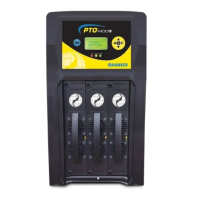Do you have a question about the Hawker LIFEPLUS MOD3 Series and is the answer not in the manual?
Instruction to preserve the owner's manual for future reference.
Covers essential safety guidelines for operating the battery charger.
Explains how to identify the charger's part and UL model numbers.
Details letter codes for cabinet sizes and DC cable gauges.
Defines letter codes for AC line voltage and frequency.
Lists available specialty options for the charger.
Guidance on selecting an appropriate and safe location for the charger.
Details on mounting the charger cabinet vertically on walls or floors.
Instructions for making safe and correct electrical connections.
Information on necessary branch circuit protection and disconnect methods.
Guidance on correct DC plug polarity and essential grounding.
Describes the microprocessor-controlled operation and battery compatibility.
Explains how the charger automatically starts charging when a battery is connected.
Details how charging current is determined and adjusts during the charge.
Describes charger behavior and data preservation during AC power interruptions.
Explains requirements and procedures for charging batteries in series.
Describes the wireless device for real-time battery diagnostics and performance.
Covers various charging profiles, equalization, and float charge functions.
Describes TPPL battery technology for enhanced performance and lifespan.
Describes automatic battery recognition and available charging profile selection.
Defines essential acronyms and abbreviations used in the manual.
Defines terms related to the charger's display and interface components.
Details on the LCD display, navigation buttons, status LED, and USB port.
Shows charger status when no battery is connected or active.
Illustrates the main menu and how to navigate its options.
Explains how to access and navigate through the main menu options.
Configuration settings for date, time, language, display, energy, and network.
Handles saving and loading charger setup and history data using USB.
Procedures for updating charger and power module firmware through USB.
Configures battery capacity, temperature limits, and automatic adjustments.
Settings for ionic profile compensation and AGV application offset.
Configuring charge profiles, ionic coefficient, and AGV offset.
Mode for trained service technicians; consult service manual.
Setting days, time, and delay for the equalization charge cycle.
Configures charge delays, blockout times, conditional charging, and daily start times.
Settings for cool down, float charge, and refresh charging modes.
Settings for cabinet size, modules, voltage, DC cables, and charger options.
Enables or disables communication with the Battery Boss Wireless Connection.
Enables/disables Electrovalve option and sets its duration.
Input for charger serial number, used when replacing HMI/display.
Input for customer asset number, used for tracking data.
Details displayed on the charger screen when idle.
How to initiate a battery charge cycle automatically or manually.
Explains how charging begins after a programmed delay.
Describes the countdown before charging starts without BBWC.
Details the scanning, syncing, and enumerating steps for BBWC connection.
Describes parameters shown on the charging display, like voltage, current, and profile.
Shows 'Charge Complete' status, Amp Hours returned, and total charge time.
How to initiate an equalize charge manually at any time.
Explains automatic equalization based on programmed settings.
Displays serial number, asset number, and counts for connects, charges, and equalizes.
Lists common faults, their causes, and recommended solutions for resolution.
Explains the meaning of LED indicators on the charger modules.
Provides detailed dimensions for mounting the 3-bay charger cabinet.
Provides detailed dimensions for mounting the 6-bay charger cabinet.
Warning about dangerous voltages and requirement for qualified personnel.
Advice on keeping connections clean, tight, and ensuring ventilation.
Identifies key components like AC input, DC output, fuses, and module slots.
| Input Frequency | 50/60 Hz |
|---|---|
| Operating Temperature | -20°C to +50°C |
| Dimensions | Varies by model |
| Weight | Varies by model |
| Battery Type | Lead-acid |
| Output Voltage | 24V, 36V, 48V, 80V |
| Protection Features | Over Temperature, Short Circuit |
| Cooling Method | Forced Air |
| Compliance | CE |












